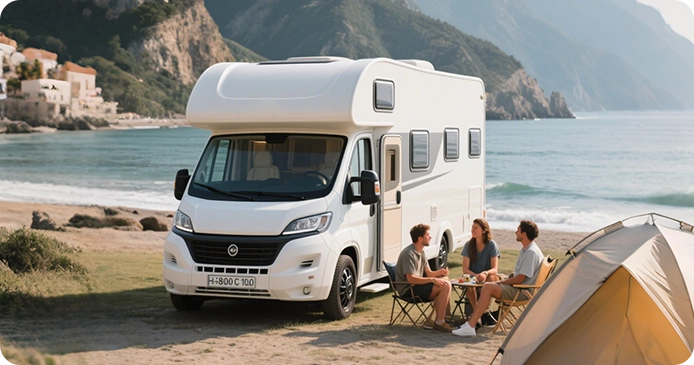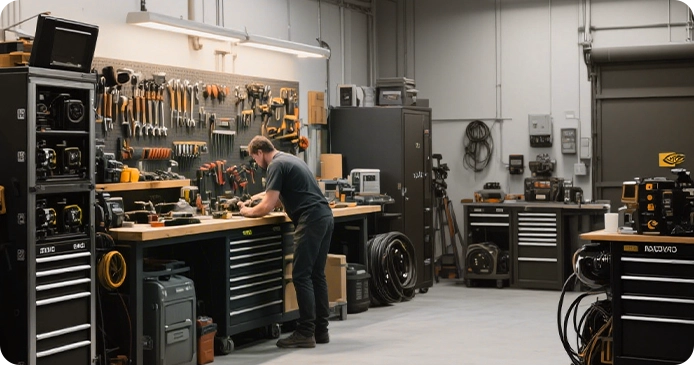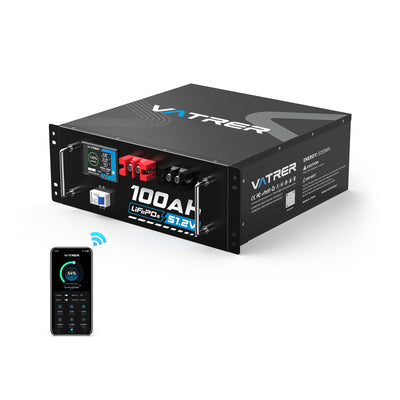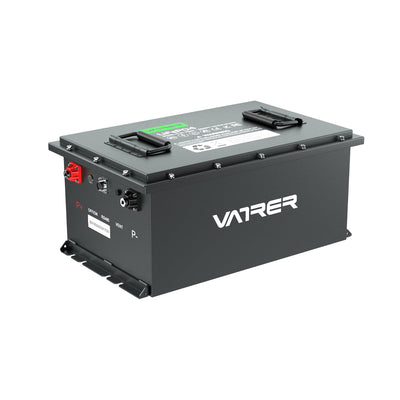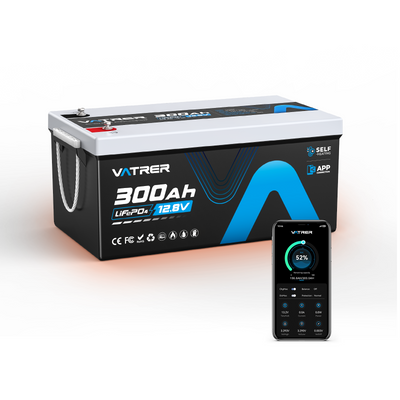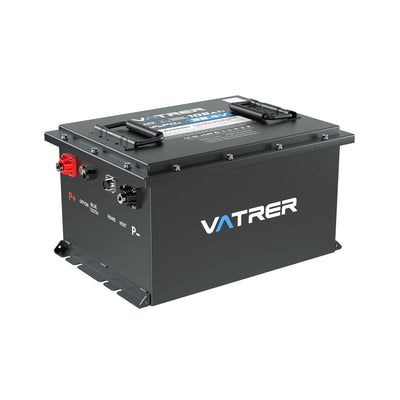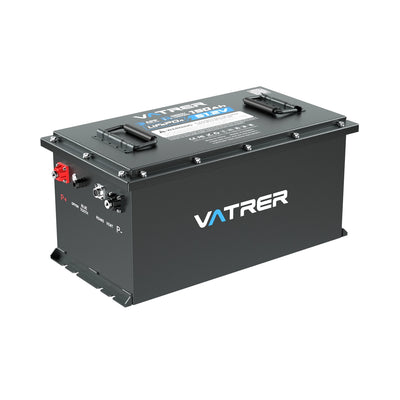
How To Charge a Deep Cycle Battery: Comprehensive Guide
Powering your RV, boat, or solar system relies on a deep-cycle battery, but charging it correctly is key to performance and longevity. This guide simplifies the process, offering clear steps to choose the right deep cycle battery charger and charge safely, whether you’re using lithium (LiFePO4), AGM, or flooded batteries.

What Are Deep Cycle Batteries and Their Uses?
Deep cycle batteries are built to deliver consistent power over long periods, making them distinct from starter batteries that crank engines with short, high-energy bursts. Their robust design, featuring thicker plates and denser materials, allows them to handle repeated deep discharges without damage.
They're essential for applications like RVs, marine systems, solar setups, trolling motors, and even electric vehicles or renewable energy storage, where sustained energy is critical. Lithium (LiFePO4) batteries, such as Vatrer battery, are gaining popularity for their high energy density, lighter weight, and eco-friendly profile, making them a top choice for modern off-grid needs.
Common Types of Deep Cycle Batteries
- Flooded Lead-Acid: Cost-effective, with liquid electrolytes requiring regular water top-ups and ventilation due to gas emissions during charging.
- AGM (Absorbent Glass Mat): Maintenance-free, vibration-resistant, and faster-charging, ideal for rugged environments like 4WDs or boats.
- Gel: Resilient to temperature extremes but sensitive to overcharging, needing precise charger settings.
- Lithium (LiFePO4): Lightweight, with up to 5,000 cycles and deeper discharge capabilities, perfect for high-performance setups. Vatrer lithium deep cycle batteries offer advanced features like built-in BMS for safe, efficient charging.
Understanding your battery type sets the foundation for choosing the right 12V deep cycle battery charger and charging method.
Why Proper Charging Boosts Your Deep Cycle Battery’s Life
Charging your deep cycle battery correctly isn’t just about keeping your devices powered, it’s about maximizing lifespan, ensuring reliable performance, and staying safe. Proper techniques can significantly extend your battery’s life, especially for lithium batteries that can power a trolling motor for years with proper care.
Risks of Improper Charging
- Undercharging: Causes sulfation in lead-acid batteries, reducing capacity and runtime, so a marine battery may fail mid-trip.
- Overcharging: Leads to overheating, water loss in lead-acid batteries, or potential damage in lithium batteries, though advanced BMS, like in Vatrer batteries, mitigates this risk.
- Safety Hazards: Improper handling, especially with flooded batteries, can release hydrogen gas, increasing explosion risks.
Benefits of Proper Charging
- Extends lifespan, with lithium batteries reaching 2,000-5,000 cycles compared to 300-1,000 for lead-acid.
- Ensures consistent power for critical applications, like running a fridge in an RV or a solar system at night.
- Enhances safety by using a compatible deep-cycle battery charger and following best practices.
So, no matter what deep-cycle battery you have, charging it correctly will protect your investment and provide reliable power for your adventures.
Key Specs to Know for Charging Your Deep Cycle Battery
Before charging, understanding your battery's specifications ensures you select the right good battery charger for deep cycle use and apply the correct settings for optimal performance.
Essential Battery Specifications
- Voltage: Most deep cycle batteries are 12V, but charging voltages vary by type.
- Amp-Hour (Ah) Rating: Measures capacity. A 100Ah battery stores 100 amp-hours, affecting charging time and charger choice.
- Depth of Discharge (DoD): Indicates safe discharge levels. Lithium supports 80-100% DoD, while lead-acid is best kept above 50% to avoid damage.
- Battery Management System (BMS): Found in lithium batteries like Vatrer, a BMS balances cell voltages, monitors temperature, and prevents overcharging or over-discharging, ensuring safe and efficient cycles.
These specs guide your charging strategy, ensuring efficiency and longevity:
| Battery Type | Bulk Voltage | Float Voltage |
|---|---|---|
| Flooded Lead-Acid | 14.4 - 14.8V | 13.2 - 13.6V |
| AGM | 14.4 - 14.7V | 13.2 - 13.5V |
| Gel | 14.1 - 14.4V | 13.1 - 13.3V |
| Lithium (LiFePO4) | 14.4 - 14.8V | 13.4 - 13.6V |
How to Choose the Best Deep Cycle Battery Charger
Choosing the best deep cycle battery charger is not only crucial for safe and efficient charging, but also requires a charger that matches your battery chemistry and capacity to ensure optimal charging performance and protect your investment.
Matching Charger to Battery Chemistry, each battery type has unique needs:
- Flooded Lead-Acid: Requires chargers with 10% of Ah rating, such as 10A for 100Ah and ventilation for gas emissions.
- AGM/Gel: Needs precise voltage settings to avoid drying out electrolytes, typically 20% of Ah rating.
- Lithium (LiFePO4): Demands a dedicated lithium deep cycle battery charger to match its voltage profile. Vatrer's lithium batteries pair well with smart chargers like the Victron Blue Smart series for precise LiFePO4 charging. It is worth mentioning that it is recommended to purchase the same original charger as the battery. If you purchase a Vatrer lithium battery, you will need a dedicated lithium charger designed by Vatrer.
Charger Output Considerations
- Amperage: Choose 10-20% of the battery's Ah rating for lead-acid (10-20A for 100Ah), lithium can handle higher rates (20-40A).
- Voltage: Ensure the charger matches the battery's voltage (a 12V deep cycle battery charger for a 12V battery).
Benefits of Use Smart Chargers
A smart charger for deep-cycle battery adjusts automatically through:
- Bulk Stage: High current to reach ~80% capacity.
- Absorption Stage: Constant voltage, reducing current as the battery nears full.
- Float Stage: Low voltage to maintain charge, ideal for long-term storage.
Onboard vs. Portable Chargers
| Charger Type | Benefits | Drawbacks | Best For |
|---|---|---|---|
| Onboard | Integrated, optimized for specific systems | Less flexible, tied to one setup | Static systems (solar) |
| Portable | Flexible for multiple batteries | Requires manual monitoring | Mobile use (camping, boating) |
For marine applications, a marine deep-cycle battery charger offers durability against moisture and vibrations, while portable chargers suit varied setups like RVs.
Charging Mixed Systems
For hybrid setups, such as AGM and lithium in a solar system, use multi-bank chargers to deliver the correct profile to each battery type, ensuring safe and efficient charging.
Charging Methods for Your Deep Cycle Battery: From Solar to Smart Tech
Different charging methods suit various scenarios, from initial setup to regular maintenance. Exploring these options helps you choose the best approach for your needs.
Initial Charging
New batteries, especially lithium, need a proper initial charge to condition cells:
- Charge slowly to stabilize cells and avoid stress.
- Monitor temperature to prevent overheating.
- Avoid interruptions for optimal cell conditioning.
Normal Charging
Regular charging replenishes energy after use:
- Use a compatible deep-cycle battery charger for your battery type.
- Check voltage regularly to avoid over- or undercharging.
- Follow battery manufacturer-recommended rates, 10-20% of Ah for lead-acid, up to 40% for lithium.
Alternative Charging Methods
- Solar Charging: Eco-friendly, using a solar deep cycle battery charger with an MPPT controller for 20-30% better efficiency than PWM. Ideal for off-grid setups.
- Generators: Reliable for remote areas but noisy and fuel-dependent.
- Alternators: Charges via the vehicle engine, efficient for RVs or boats.
- Combined Methods: Merges solar and generator for flexibility in variable conditions.
Smart Charging Technologies
Modern chargers, like the NOCO Genius series, use AI to adjust dynamically to battery conditions, improving efficiency and safety. These are ideal for users seeking an advanced smart charger for deep cycle battery options.
Step-by-Step Guide to Charging Your Deep Cycle Battery
Following the steps below will help you charge your deep-cycle battery correctly and make it easier to practice, ensuring safety and efficiency.
Step 1: Prepare the Battery
- Inspect for damage, cracks, or leaks.
- Clean terminals to remove corrosion for better conductivity.
- Ensure a well-ventilated area, especially for flooded batteries, to disperse hydrogen gas.
Step 2: Connect the Charger Safely
- Attach the positive (red) clamp to the positive terminal and the negative (black) clamp to the negative terminal.
- Secure connections to avoid sparks; connect to the battery before plugging into the mains.
- Disconnect in reverse order, unplug from mains, then remove clamps.
Step 3: Understand Charging Stages
A smart charger for deep-cycle battery manages these stages:
- Bulk: High current to quickly reach 80% capacity.
- Absorption: Steady voltage with decreasing current to near full charge.
- Float: Low voltage to maintain charge without overcharging.
Step 4: Monitor the Charging Process
- Check charger indicators (green for full charge) or use a voltmeter (12.6-12.8V for lead-acid, 13.3-13.4V for LiFePO4). If errors occur (flashing red), check for loose connections or overheating and consult the manual.
- Set a timer based on capacity and charger output (a 100Ah battery with a 10A charger takes ~5-6 hours for 50% DoD).
- For flooded batteries, check electrolyte levels post-charge and top up with distilled water if needed, avoiding overfilling.
Step 5: Tailor to Your Battery Type
- Flooded: Ensure ventilation and check water levels.
- AGM/Gel: Use precise voltage settings to prevent drying out.
- Lithium: Use a lithium deep cycle battery charger.
Vatrer LiFePO4 deep cycle batteries use an advanced BMS to prevent overcharging and extreme temperatures, with low temperature protection and Bluetooth monitoring capabilities. Combined with Vatrer smart charger three-stage protection function, it maximizes your battery charging safety and ensures efficient charging.
How to Charge Different Deep Cycle Battery Types
Each battery type has unique charging needs to ensure longevity and performance.
Flooded Lead-Acid Batteries
- Require maintenance (water top-ups, ventilation), charge at 10% of Ah rating.
- Sensitive to overcharging, which causes water loss and plate damage.
- Last 300-500cycles with proper care.
AGM Batteries
- Maintenance-free, ideal for rugged applications like marine or 4WD setups.
- Charge at 20% of Ah rating with precise voltage to avoid drying out.
- Last 500-1,000 cycles, use a marine deep cycle battery charger for boat durability.
Gel Batteries
- Resilient to temperature extremes but sensitive to over-voltage.
- Last 500-1,000 cycles with correct charger settings.
Lithium (LiFePO4) Batteries
- Offer 2,000-5,000 cycles, 95% charge efficiency, and up to 100% DoD.
- Require a dedicated lithium deep cycle battery charger (14.4-14.8V bulk).
- Vatrer lithium batteries include BMS with low-temp cutoff, ensuring safe charging in varied conditions.
How Long to Charge Your Deep Cycle Battery
Charging time depends on battery type, capacity, depth of discharge (DoD), and charger output.
| Battery Type | Charging Time (100Ah, 50% DoD, 10A Charger) |
|---|---|
| Flooded Lead-Acid | 8 - 14 hours |
| AGM | 8 - 10 hours |
| Gel | 10 - 14 hours |
| Lithium (LiFePO4) | 2 - 4 hours (20A charger) |
When to Recharge
- Recharge at ~50% SOC to extend lifespan, deeper discharges reduce cycle life, especially for lead-acid.
- Use voltmeters or apps to monitor SOC and avoid over-discharging.
Avoiding Overcharging
- Lead-Acid: Overcharging causes water loss and plate exposure.
- Lithium: Risks overheating, but Vatrer's BMS cuts off current at full capacity to prevent damage.
- Use a smart charger for deep-cycle battery to switch to float mode automatically.
A 100Ah lithium battery at 50% DoD with a 20A lithium deep cycle battery charger takes ~2-4 hours, accounting for 95% charge efficiency and BMS regulation.
Safety Tips for Charging Your Deep Cycle Battery
Safety is critical to avoid accidents and ensure efficient charging.
- Ventilation: Charge in a well-ventilated area, especially for flooded batteries, to disperse hydrogen gas.
- Protective Gear: Wear gloves and safety goggles to protect against acid splashes or sparks.
- Temperature Control: Charge between 32°F and 113°F (0°C-45°C) for lithium batteries like Vatrer's to avoid BMS cutoffs, avoid above 120°F (49°C) for all types.
- Connection Safety: Ensure correct clamp connections and avoid metallic objects near terminals to prevent short circuits.
Deep Cycle Battery Charging Common Troubleshooting
| Issue | Cause | Solution |
|---|---|---|
| Slow Charging | Mismatched charger or low amperage | Use a deep cycle battery charger with 10-20% of Ah rating; check connections |
| Overcharging | Incorrect voltage or basic charger | Use a smart charger for deep cycle battery with float mode |
| Sulfation (Lead-Acid) | Chronic undercharging | Use a charger with desulfator mode or replace battery |
| Charger Errors | Overheating or connection issues | Check manual for error codes; ensure ventilation |
| Lithium BMS Errors | High temperature or overvoltage | Move to 32-113°F (0-45°C) environment; use LiFePO4-compatible charger |
If issues persist, consult the battery or charger manual or a professional technician.
Conclustion
Proper charging and maintenance ensure your deep cycle battery delivers reliable power for your adventures, from RV trips to off-grid living. By selecting the best deep cycle battery charger for your battery type, whether flooded, AGM, gel, or lithium and following safe, tailored practices, you'll maximize performance and lifespan.
Now that you understand and master the correct way to charge a deep-cycle battery, are you still interested in learning more about deep-cycle batteries? For more information, please visit:
What is a Deep Cycle Lithium Battery Used For?
How Long Does a Deep-Cycle Battery Last?
How Do You Understand The Group 24 Size Deep-Cycle Battery?
FAQs
How To Charge a Marine Deep Cycle Battery?
Charging a marine deep cycle battery requires a charger designed for the marine environment, such as a marine deep cycle battery charger, which is built to withstand moisture, vibrations, and salt exposure.
For AGM batteries, commonly used in boats, select a charger with a 20% amp-hour (Ah) rating and precise voltage settings (14.4-14.7V bulk, 13.2-13.5V float).
For lithium (LiFePO4) marine batteries, like those from Vatrer, use a dedicated lithium deep cycle battery charger with a 14.4-14.8V bulk setting.
Ensure the battery is charged in a well-ventilated area, and check connections for corrosion due to marine conditions. Charge at 50% state of charge (SOC) to maximize lifespan (500-1,000 cycles for AGM, 2,000-5,000 for lithium).
For extended trips, use an onboard marine deep-cycle battery charger connected to the boat's alternator for continuous charging, or pair with a solar deep-cycle battery charger for eco-friendly power during downtime.
What Should I Do If I Only Have a Charger That Doesn't Match My Deep Cycle Battery Type?
Using a non-matching deep-cycle battery charger is not recommended, as it can lead to inefficient charging or damage. Such as a standard car charger may overcharge an AGM or flooded lead-acid battery, causing water loss, or fail to meet the voltage needs of a lithium battery, risking BMS errors.
In an emergency, if no compatible charger is available, use the closest voltage setting (12V for a 12V battery) and monitor closely with a voltmeter (aim for 12.6-12.8V for lead-acid, 13.3-13.4V for lithium when full).
Disconnect immediately once charged to avoid overcharging. For a reliable long-term solution, invest in a smart charger for deep cycle battery that supports multiple battery types, like those compatible with Vatrer's lithium batteries, to ensure safe and efficient charging.
How Do i Know If My Deep Cycle Battery Is Damaged During Charging?
Signs of damage during charging include excessive heat (above 120°F/490°C), swelling, leaks (for flooded batteries), or a burning smell, indicating potential overcharging or internal faults.
For lithium batteries, a BMS error (charger cutoff) may signal overvoltage or temperature issues. Use a voltmeter to check if the battery holds a charge (below 12V for lead-acid or 13V for lithium after charging suggests damage).
For flooded batteries, check electrolyte levels, exposed plates indicate water loss from overcharging. If damage is suspected, stop charging immediately, ensure ventilation, and test the battery with a load tester or consult a professional.
To prevent damage, use a good battery charger for deep cycle with correct settings, such as Vatrer's recommended lithium deep cycle battery charger for LiFePO4 batteries, and avoid charging in extreme temperatures.
How Can i Optimize Charging For a Deep Cycle Battery In a Solar Setup With Limited Sunlight?
Limited sunlight can slow charging in a solar deep-cycle battery charger setup, but optimization is possible. Use an MPPT (Maximum Power Point Tracking) solar charge controller for 20-30% better efficiency than PWM, maximizing power capture in low-light conditions.
For a 100Ah battery, pair with a 200-300W solar panel to ensure sufficient input, even on cloudy days. Prioritize lithium batteries, like the Vatrer battery, which charge faster (2-4 hours for 100Ah at 50% DoD with a 20A charger) and have 95% efficiency.
Store the battery at 50-80% SOC to reduce charging needs, and consider a backup generator for extended overcast periods.
Regularly clean solar panels to remove dust, and angle them toward the sun to boost output. Monitor SOC with a battery app or voltmeter to prioritize essential loads when sunlight is scarce.
Share




























